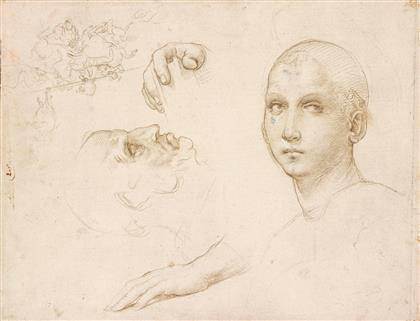
Raphael: Studies of heads and hands, and sketches after Leonardo, c. 1505–7 Metalpoint, white heightening, partially oxidised, on white prepared paper, 21 x 27.4 cm © Ashmolean Museum, University of Oxford
Ashmolean Museum presents ‘Raphael: The Drawings’ 120 works by Raphael from international collections go on show at the Ashmolean in the once-in-a-lifetime exhibition ‘Raphael: The Drawings’. 1 June–3 September 2017.]]>
Source: Ashmolean Museum
Fifty works come from the Ashmolean’s own collection, the largest and most important group of Raphael drawings in the world. They arrived in 1845 following a public appeal to acquire them after the dispersal of the collection of the portrait painter Sir Thomas Lawrence (1769–1830), who had amassed an unrivalled collection of Old Master drawings. A further twenty-five works are on loan from the Albertina Museum, Vienna, which will show the exhibition in autumn 2017. The remaining drawings come from international collections and include “The Head of a Muse” (private collection) which broke the records when auctioned at Christies in 2009.
Dr Xa Sturgis, Director of the Ashmolean Museum, says: ‘Not since 1983, when an exhibition of drawings from British collections was on view at the British Museum, has such an extraordinary gathering of Raphael drawings been shown to the public. The generosity of lenders and supporters has enabled us to give people a ‘once in a generation’ opportunity – that of experiencing the visual and emotive power of Raphael’s hand, and of understanding Raphael’s genius.’
The 120 drawings on display are taken from across Raphael’s brief but brilliant career, taking visitors from his early career in Umbria through his radically creative years in Florence to the period when he was at the height of his powers in Rome, working on major projects such as the Vatican frescoes. The exhibition aims to transform our understanding of Raphael through a focus on the immediacy and expressiveness of his drawing. It shows how Raphael, throughout his career, engaged in an intensive search through drawing for possibilities of expression that would enable him to fulfil his far-reaching ambitions. Raphael often investigated and refined his ideas through the process and materials of drawing in ways that were more subtle or more adventurous than they would appear in his paintings, as in his nuanced portrayal of a youthful saint (c. 1505–7) that evokes not only a sculptural form, but an enigmatic, brooding character.
Related content
Raphael, Rembrandt and Domenichino lead Christie’s auction (news, 2009)
Follow us on:


